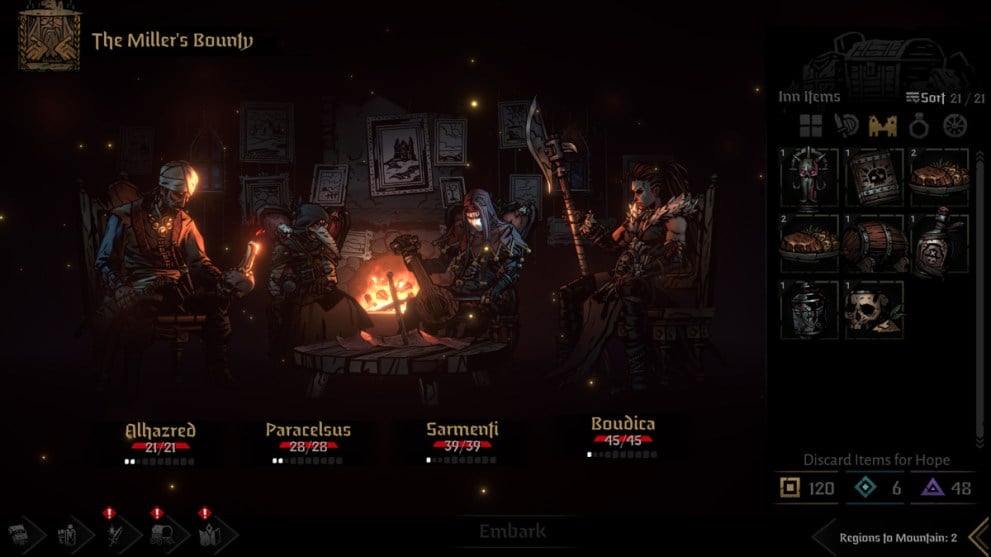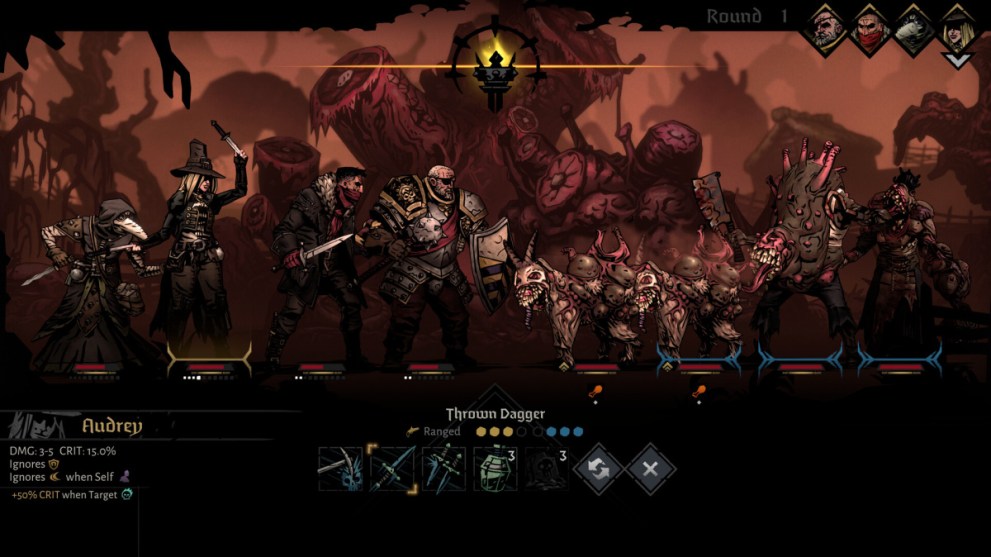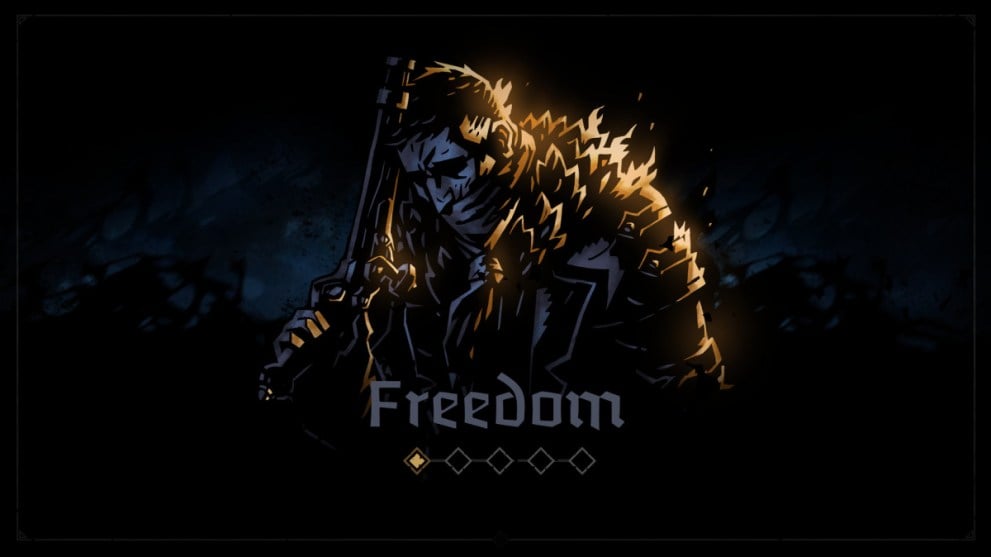Darkest Dungeon II on PC
To say Darkest Dungeon II can be a brutally punishing game would be an understatement.
On more than one occasion, I saw promising runs ground to a halt thanks to unfortunate critical hits from enemies and less than ideal abilities assigned to my party. A matter of minutes saw runs go from being the best I’d ever had to the worst I’d ever seen, and what could have been a triumphant trouncing of a boss turned into a torturous exercise in going down with the ship alongside the party members I’d led into untimely deaths.
It’s the epitome of a game that revels in pitting players against overwhelming odds. And yet, this also made overcoming the challenges the game presents that much more gratifying, and established Red Hook Studios‘ latest offering as one of the most rewarding roguelike games I’ve played in a long time.

Part of this is thanks to how Darkest Dungeon II builds upon what came before it. Similar to the first title in the series, the sequel centers around a group of troubled souls who are drawn into a mission to eliminate an eldritch force that threatens humanity. Unlike the original Darkest Dungeon though, this entry sees the forces of darkness let loose on civilization, decimating and corrupting the wider world.
As a result, the party of unlikely heroes must travel the world, fighting horrors as they go and struggling to maintain their sanity in the face of increasingly monstrous obstacles. All the while, bits and pieces of information are revealed regarding how this occurred, and what awaits those who will remain once the dust settles.
It’s a dire enough setup, and provides an excuse for some of the gameplay mechanics that have been implemented since the first game’s release. Most of these display themselves in the form of quality-of-life improvements, which serve to make the sequel feel like a huge step up in terms of ease of access and playability.
Case in point: Players now navigate linear maps and areas via a carriage which allows one’s party to traverse the game’s maps more quickly. Players can still choose where they go and what they’ll experience to an extent, but there’s no longer an option or need to go back and forth around a cramped area in order to complete missions. Players can also still fall victim to hazards and threats just as the party from the original did, but with far less resource management, backtracking, and general stress.

Alongside this were improvements ranging from more readily accessible party member types instead of randomly recruitable characters, and the elimination of the hunger mechanic altogether. Though these might seem like small features to newcomers, they end up radically changing the game and honing in on the challenge presented by the game’s combat.
Speaking of which, the battles in Darkest Dungeon II are where the title truly shines. Though it might seem like standard fare for a turn-based take on fights, the system is deceptively deep with a slew of stats, ailments, and buffs to keep track of. Failing to do so can quickly spell the difference between a successful run and one doomed to fail. There’s also factors like a party member’s positioning, and whether or not they have the damage-dealing potential needed for a given encounter.
Early on, I found myself constantly flattened by Occult enemies which seemed insurmountable due to the damage they dealt and the ailments they hit my party members with. After doing some experimenting though, I found that they could be easily dispatched by blinding, poisoning, or burning them accordingly, and then moving specific classes into position to inflict the maximum amount of damage. Before long, they ranked among the foes I could dispatch even with fairly underdeveloped party members.
Adding to this are a slew of auxiliary mechanics which serve to further influence one’s chances of survival. These include returning features like equipping Trinkets with special effects or properly treating the party during their brief respites at Inns, as well as dealing with the different traits assigned to characters which strengthen and debilitate characters in equal measure.
Alongside these are new elements such as segments which flesh out the backstories of characters in order to unlock new abilities for them, and relationships between characters that form based on their actions in combat. Utilizing them properly can prove just as pivotal in how well one’s run goes, and are worth figuring out sooner rather than later.

Granted, this is easier said than done, especially for newcomers to the franchise. As with the first game, Darkest Dungeon II can be a little obtuse in how it presents its mechanics to the player. Fresh players will have a metric ton of features thrown at them right off the bat, and the explanations for how to use them aren’t always as detailed as they could be.
There’s also the RNG elements to keep in mind. While players can certainly get around some of the title’s difficulty through experience and practice, there will still be runs that are made unsalvageable due to a string of critical hits from enemies or the worst possible traits triggering and debilitating one’s party. There’s no real way to account for this, and the only solution is usually to accept a loss even if victory seemed to be in sight moments ago.
Both of these can prove frustrating, but never serve to make the experience impossible to enjoy or a waste of time. Even if my early hours saw me overwhelmed or frustrated by sudden losses, I was always drawn back in by the potential for a better run in the future where I had a better understanding of the mechanics, or where I stumbled upon a party with the perfect traits.
Past that, the rest of Darkest Dungeon II can be commended for how well it’s designed. In terms of the art and graphics, the title shows a clear step up from the original thanks to its jump to 3D. Both via the carriage and the sprites for characters in battle, the game pops through small animations and movements. The art style bolsters these further, lending everything the same stylistic energy as the original through dark and jagged portrayals of attacks and reactions.
Sound-wise, the game is just as memorable as the first in most every regard. The music runs the gamut from morose and haunting to intense and adrenaline pumping, while the sound effects ensure players will feel every meaty blow or otherworldly howl all the way down to their bones. Special mention also goes out to Wayne June, who once again serves as the inimitable voice of the narrator throughout the adventure and lends a special flair to even the more mundane aspects of the game.
Darkest Dungeon II isn’t an easy experience to dive into, but it is a worthwhile one. Those willing to muscle through its punishing design and RNG elements will find one of the best roguelike titles around, and can expect to be drawn back into its world for months or years to come.
Pros
Cons
Steep learning curve for newcomers.
